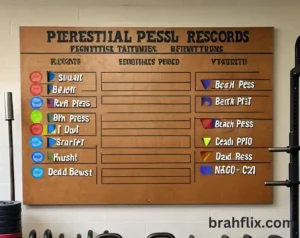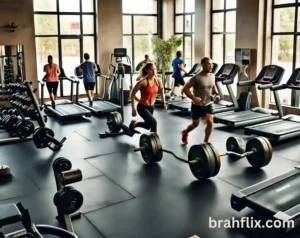Introduction
When navigating the world of fitness, you’ll often hear the term PR. But what does PR mean in the gym? In the context of fitness and strength training, PR stands for Personal Record. Achieving a PR means you’ve reached a new personal best in a particular exercise or workout metric. This term is widely used among athletes, bodybuilders, and gym-goers to signify a new peak performance level.
Key Takeaways:
- PR stands for Personal Record.
- It represents your highest achievement in a specific exercise or workout metric.
- Tracking PRs helps in setting realistic goals and measuring progress.
- Understanding PRs can enhance motivation and overall fitness performance.
What Is a Personal Record (PR) in Gym Terminology?
A Personal Record (PR) refers to the best performance you’ve achieved in a specific exercise or workout. For example, if you lift 200 pounds in a deadlift, and your previous highest was 180 pounds, your new PR is 200 pounds. PRs are essential metrics for anyone serious about fitness, as they help measure progress and set goals.
Why PRs Matter
Tracking PRs helps in several ways:
- Motivation: Seeing improvements provides motivation to continue pushing yourself.
- Goal Setting: PRs offer a concrete benchmark for setting future goals.
- Progress Tracking: They allow you to track improvements over time, which can be satisfying and informative.
- Program Adjustment: Knowing your PRs helps in adjusting your training program to avoid plateaus and achieve better results.
How to Track Your PRs Effectively
Tracking your PRs is crucial for understanding and improving your fitness. Here’s how you can do it effectively:
1. Record Your Metrics
Keep a detailed log of your workouts. Include:
- Exercise performed
- Weight lifted or resistance used
- Repetitions and sets
- Date of the workout
2. Use Technology
Fitness apps and tracking devices can automate the process:
- Fitness Apps: Apps like MyFitnessPal, Fitbod, and JEFIT can help record and analyze your PRs.
- Wearable Devices: Smartwatches and fitness trackers can also monitor your performance and help track improvements.
3. Regular Testing
Test your limits regularly but safely:
- Frequency: Perform PR tests every few weeks to monitor progress without risking overtraining.
- Form and Safety: Ensure proper form to prevent injuries while pushing for new PRs.
Common Types of PRs in the Gym
Personal Records can vary widely depending on the type of exercise. Here are some common types:
1. Strength PRs
These involve the maximum amount of weight you can lift:
- Bench Press: Maximum weight you can lift in a bench press.
- Squat: Maximum weight in a squat.
- Deadlift: Maximum weight in a deadlift.
2. Endurance PRs
These are related to how long or how many repetitions you can perform:
- Running Distance: Longest distance you can run without stopping.
- Time-Based Workouts: Maximum repetitions or distance in a set time frame.
3. Flexibility PRs
These measure your flexibility and range of motion:
- Stretching: Maximum flexibility in specific stretches.
- Yoga Poses: Holding a yoga pose for the longest duration or achieving a difficult pose.
4. Skill-Based PRs
These involve skills or techniques:
- Olympic Lifts: Maximum weight in Olympic lifts like the snatch or clean and jerk.
- Gymnastics Moves: Performance of complex gymnastic movements.
How PRs Impact Your Fitness Goals
Personal Records are more than just numbers; they significantly impact your overall fitness journey:
1. Enhancing Motivation
Achieving a PR can be incredibly motivating:
- Sense of Accomplishment: Reaching a new PR provides a strong sense of achievement.
- Visual Progress: Seeing concrete improvements in your records reinforces your commitment.
2. Refining Training Programs
PRs help in tailoring your training:
- Identifying Strengths and Weaknesses: Understanding where you excel and where you need improvement.
- Adjusting Workouts: Modifying your training regime to focus on areas requiring more attention.
3. Preventing Plateaus
Regularly updating PRs helps in avoiding training plateaus:
- New Challenges: Setting new records challenges your body and prevents stagnation.
- Adaptation: Ensuring your training program adapts to your growing capabilities.
Tips for Achieving New PRs
Breaking through to new PRs requires strategy and dedication. Here are some tips:
1. Consistency
Stay consistent with your workouts and training:
- Regular Sessions: Regularly scheduled workouts help build strength and endurance.
- Recovery: Allow adequate recovery time to prevent injuries and improve performance.
2. Proper Nutrition
Fuel your body correctly:
- Balanced Diet: Ensure a diet rich in proteins, carbohydrates, and fats to support muscle growth and recovery.
- Hydration: Maintain proper hydration to optimize performance and recovery.
3. Adequate Rest
Rest is crucial for muscle recovery:
- Sleep: Aim for 7-9 hours of sleep per night.
- Rest Days: Include rest days in your routine to allow your muscles to recover and grow.
4. Form and Technique
Maintaining proper form is vital:
- Proper Technique: Avoid injuries and maximize effectiveness by using correct form.
- Professional Guidance: Consider working with a personal trainer to ensure proper technique and form.
Understanding the Psychological Impact of PRs
Achieving a new PR can have significant psychological benefits:
1. Boosting Self-Esteem
Personal achievements enhance self-esteem:
- Confidence: Hitting new PRs boosts your confidence in your abilities.
- Self-Worth: Achievements affirm your dedication and hard work.
2. Reducing Stress
Exercise, including achieving PRs, can help reduce stress:
- Endorphin Release: Physical activity triggers endorphin release, improving mood and reducing stress.
3. Creating a Positive Feedback Loop
Success breeds more success:
- Motivation Loop: Achieving a PR often leads to setting new goals and striving for further improvements.
- Increased Commitment: Seeing progress encourages greater commitment to your fitness routine.
How to Set Realistic Goals Based on PRs
Setting realistic goals based on your PRs can enhance your fitness journey:
1. SMART Goals
Apply the SMART criteria to your goals:
- Specific: Clearly define what you want to achieve.
- Measurable: Ensure your goals are quantifiable.
- Achievable: Set goals that are challenging yet attainable.
- Relevant: Align goals with your overall fitness objectives.
- Time-Bound: Set a timeframe for achieving your goals.
2. Gradual Progression
Set incremental goals:
- Short-Term Goals: Focus on small, achievable milestones.
- Long-Term Goals: Establish broader objectives based on cumulative progress.
3. Regular Assessment
Assess your progress periodically:
- Review and Adjust: Regularly review your PRs and adjust your goals as needed.
FAQs
1. How often should I test my PRs?
Testing your PRs every 4-6 weeks is generally recommended. Ensure you allow adequate recovery time between tests to avoid overtraining and injuries.
2. Can I track PRs for every exercise?
Yes, you can track PRs for various exercises, including strength, endurance, flexibility, and skill-based movements.
3. What should I do if I hit a plateau?
If you hit a plateau, consider adjusting your workout routine, increasing intensity, or incorporating new exercises to challenge your body in different ways.
4. How do I stay motivated after achieving a PR?
Set new, progressive goals to maintain motivation. Consider focusing on different areas of fitness or setting higher targets to continue challenging yourself.
5. Is it safe to push for new PRs frequently?
While pushing for new PRs can be motivating, it’s important to balance this with adequate rest and recovery to prevent injuries and ensure long-term progress.
Conclusion
Understanding what PR means in the gym is crucial for tracking your progress and achieving your fitness goals. Personal Records are a powerful way to measure improvements, set new goals, and stay motivated. By effectively tracking and striving for new PRs, you can enhance your fitness journey, break through plateaus, and achieve greater results.
Have you set any personal records lately? Share your experiences and goals in the comments below, and don’t forget to check out our other blogs for more fitness tips and advice!